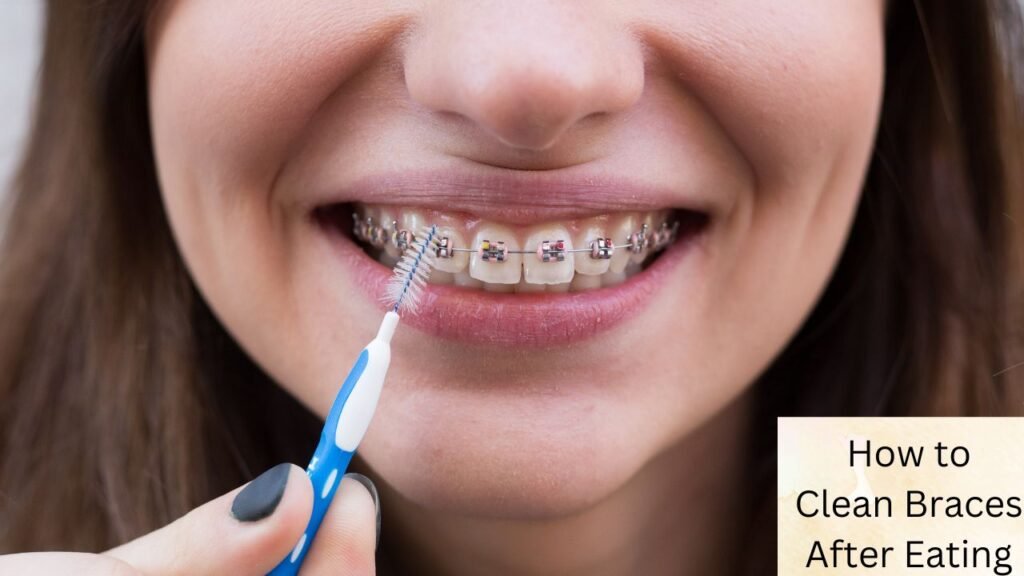Braces can transform your smile, but they also come with their own set of challenges, especially when it comes to keeping your teeth clean.
Food particles and plaque have a tendency to get trapped around the brackets and wires, making oral hygiene crucial. In this guide, we’ll explore how to effectively clean your braces after eating, so you can maintain a healthy mouth and avoid common dental issues.
Why Proper Braces Cleaning is Essential

Keeping your braces clean isn’t just about avoiding bad breath or keeping your teeth looking good—it’s about preventing serious dental issues. Here’s why it’s so important:
- Plaque Buildup: Food particles stuck in braces can quickly turn into plaque, which hardens into tartar. Tartar buildup can lead to cavities, gum disease, and other oral health problems.
- Tooth Discoloration: Plaque and tartar can cause stains on your teeth that remain even after your braces are removed. Proper cleaning helps prevent these unsightly stains.
- Gum Recession: Poor oral hygiene can lead to gum disease, which may cause your gums to recede. This can affect the alignment of your teeth and prolong your orthodontic treatment.
- Extended Treatment Time: Dental problems caused by inadequate cleaning can delay the completion of your orthodontic treatment. Maintaining good hygiene ensures your treatment progresses as planned.
By following a thorough cleaning routine, you can keep your mouth healthy and your braces working effectively.
Essential Tools for Effective Brace Cleaning
To maintain optimal oral hygiene with braces, you’ll need the right tools. Here’s a breakdown of what you need and why:
- Toothbrushes
- Manual Toothbrushes: A soft-bristled toothbrush, such as the Oral-B Ortho Care, is designed specifically for cleaning around braces. Its bristle arrangement helps clean between brackets.
- Electric Toothbrushes: Consider using the Philips Sonicare for Kids or similar models, which offer gentle yet thorough cleaning with features tailored for braces.
- Interdental Brushes: The GUM Soft-Pick is ideal for maneuvering around brackets and wires, effectively removing trapped food particles.
- Dental Floss and Floss Threaders
- Dental Floss: Use waxed floss like Glide Pro-Health to avoid shredding between teeth and braces.
- Floss Threaders: Tools like the DenTek Easy Brush can help you thread floss behind the wire, making it easier to clean.
- Water Flossers
- Water Flossers: The Waterpik Aquarius is a powerful tool for flushing out food particles and plaque from around braces, ensuring a thorough clean.
- Mouthwash
- Mouthwash: An alcohol-free mouthwash like Listerine Total Care can help reduce plaque and keep your breath fresh. It’s a crucial step in your oral hygiene routine.
Step-by-Step Cleaning Routine
Maintaining clean braces requires a systematic approach. Follow these steps to ensure your braces—and your smile—stay in top condition:
- Brushing
- Start by using a soft-bristled or electric toothbrush. Hold the brush at a 45-degree angle to the gum line.
- Brush the brackets and wires gently, making sure to clean all surfaces: the front, back, and chewing surfaces of your teeth.
- Brush for at least two minutes to ensure you cover all areas.
- Flossing
- Use a floss threader or orthodontic floss. Carefully guide the floss behind the wire and clean between each tooth.
- Avoid snapping the floss, as it can damage the wire or cause discomfort.
- Using Interdental Brushes
- Insert the interdental brush between teeth and gently move it back and forth. This helps dislodge any food particles stuck around the brackets.
- Water Flossing
- Direct the water flosser’s stream at the gumline and between teeth. This helps flush out debris and plaque.
- Mouthwash
- Rinse with mouthwash for 30 seconds. This step helps reduce plaque and refreshes your breath.
Handling Specific Food Challenges
Certain foods are particularly challenging when it comes to braces. Here’s how to deal with them:
- Sticky Foods
- Items like caramel or gum can cling to your braces. Rinse your mouth with water immediately after eating and brush thoroughly to remove sticky residues.
- Sugary Foods
- Sugar increases plaque buildup. After consuming sugary foods, brush your teeth and use interdental brushes to clean around the braces.
- Acidic Foods
- Acidic foods, like citrus fruits, can erode tooth enamel. Wait 30 minutes before brushing to prevent damage to the enamel.
- Popcorn and Nuts
- These can get stuck in braces. Use a water flosser to remove stubborn particles and avoid hard foods that can damage your braces. Some of these are also among the foods that cause chipped teeth, so avoiding them protects more than just your orthodontic work.
- Chewy Candy
- Chewy candy can be difficult to clean. Rinse your mouth thoroughly and brush your teeth immediately after consumption.
Additional Tips for Brace Care
- Orthodontic Wax
- Apply orthodontic wax to brackets or wires causing irritation. This helps prevent sores and discomfort. If you notice swelling or a bump on the roof of your mouth, it could be due to irritation or infection—so don’t ignore it.
- Handling Broken Brackets or Wires
- If a bracket breaks or a wire becomes loose, contact your orthodontist immediately to avoid further issues.
- Regular Dental Checkups
- Maintain regular orthodontic appointments to ensure your braces are functioning correctly and to address any concerns.
Frequently Asked Questions (FAQs)
Conclusion
Keeping your braces clean after eating is essential for maintaining good oral health and ensuring the success of your orthodontic treatment. By using the right tools and following a consistent cleaning routine, you can prevent dental problems and keep your smile shining bright. Remember, regular checkups and good hygiene practices are key to a successful orthodontic journey.
Share this guide with friends and family who might find it useful, and don’t hesitate to consult your orthodontist for personalized advice and recommendations. Start implementing these tips today and enjoy a healthier, more confident smile!
Find Your Perfect Dentist
Book appointments with top-rated dentists in your area